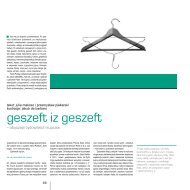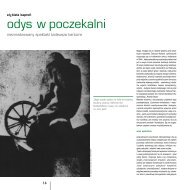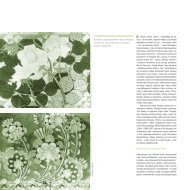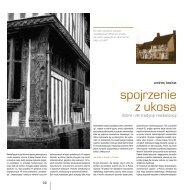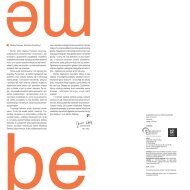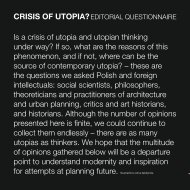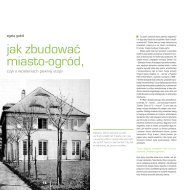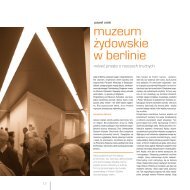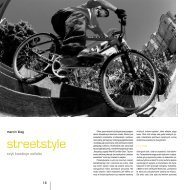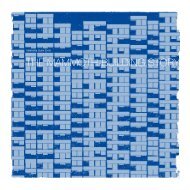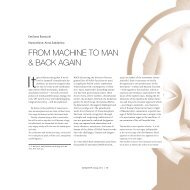CONCRETE GARDEN - Autoportret
CONCRETE GARDEN - Autoportret
CONCRETE GARDEN - Autoportret
You also want an ePaper? Increase the reach of your titles
YUMPU automatically turns print PDFs into web optimized ePapers that Google loves.
Michał Wiśniewski<br />
ConCrete garden<br />
housing estate – a grey linear<br />
The reality of Polish towns – rarely<br />
arouses positive emotions. It is most commonly<br />
perceived as a sick whim and a great<br />
mistake of modern architecture. Alienation<br />
and social pathologies lurking beneath prefabricated<br />
architecture have cast a shadow<br />
on the rich discourse of modernism, which<br />
lay at the heart of post-war mass urbanisation.<br />
Its motor was a utopian vision of a<br />
brave new world, a Garden of Eden without<br />
wars, sickness or hunger. Unlike many<br />
earlier utopias, the post-war one was implemented.<br />
Showing no consideration for<br />
surroundings nor energy usage costs, 20th century modernists created an extremely<br />
anthropocentric programme that forever<br />
changed the human environment. Modernism<br />
triumphed throughout almost the<br />
entire world with a series of monumental<br />
complexes, with Polish ones being just one<br />
example among many, and not necessarily<br />
the most intriguing or irritating.<br />
The desire to build a new world was an idea<br />
which frequently accompanied disagreement<br />
on the subject of the encountered reality. The<br />
history of modern architecture is full of rebellion<br />
and desire to fight the social system and<br />
diseases of civilisation, which pushed artists<br />
and builders towards a vision of a new – and<br />
thus a better – world. Since the end of the 19 th<br />
century, architectural modernity has been<br />
understood in military terms – as a heroic<br />
struggle with tuberculosis, illiteracy, poverty<br />
and inequalities of a society based on class.<br />
According to war logic, architects of the modern<br />
era pushed their own statue of arbiter of<br />
beauty off its pedestal, which – aware of tradition<br />
and history – they themselves had erected<br />
with the aim of expressing higher ideas and<br />
feelings. Instead of remaining in the hitherto<br />
splendour of being connoisseurs of the ideal,<br />
architects ‘descended from the heights’ to deal<br />
with the real current problems of everyday<br />
life, which they could almost touch in the<br />
increasingly large and complicated towns of<br />
the era of the industrial revolution.<br />
autoportret 2 [34] 2011 | 61<br />
Transforming themselves from engineers of<br />
beauty into engineers of society, architects<br />
of the modern era also made attempts to<br />
define anew the real living needs of people.<br />
Full of faith in technology, architects<br />
sought to subordinate people’s everyday<br />
rhythm, habits and environment to the logic<br />
of the machine. The appearance of steel,<br />
tempered glass and reinforced concrete<br />
turned aesthetic paradigms in architecture<br />
upside down and pushed architecture<br />
towards abstraction, the simplest forms and<br />
meanings. The departure from the ‘zero<br />
point’ propagated by modernists allowed<br />
construction of both the world and humans<br />
anew. While the end of the First World War<br />
brought about a collapse of faith in the<br />
bourgeois and aristocratic ideals of the 19 th<br />
century, the end of the Second World War<br />
saw a whole generation of designers shaped<br />
in a new spirit faced with the task of rebuilding<br />
from the destruction caused by the<br />
military cataclysm.
netherlands architecture institute, rotterdam − bakema archive<br />
The end of the biggest war in modern history,<br />
and a turning point in Europe, pushed a generation<br />
of pupils of the first modernists towards<br />
creation of a utopian vision of the world of the<br />
future. Instead of looking to the wisdom of the<br />
past – the 19 th century ideal – there was a sudden<br />
desire to discover the future and realise it<br />
here and now. This breakthrough moment returned<br />
repeatedly on various cultural planes.<br />
In 1948, Roberto Rossellini in the last film in<br />
his war trilogy, Germany – Year Zero, directed his<br />
camera on a thirteen year old boy wandering<br />
aimlessly through the rubble of ruined Berlin.<br />
The world in which he had grown up had just<br />
collapsed. The church, school, state, and family<br />
which shaped his identity had ceased to exist<br />
or were no longer of any significance. Surrounded<br />
by rubble – both real and social – the<br />
boy was a symbol of hope for the emergence of<br />
a new world. In the brutal image of the Italian<br />
neorealist, the life of the young German was<br />
crushed by the environment, dominated by<br />
the defeated and humiliated Nazis. However,<br />
more important than the complexities of the<br />
plot – into which crime and personal tragedy<br />
are interwoven – was the symbolic expression<br />
of a vision of youth and innocence brutally<br />
confronted with the atrophy of the world.<br />
Rossellini’s picture expressed the need for a<br />
new beginning (which was important in the<br />
post-war epoch) which was faced with the violence<br />
of a successive conflict – this time the<br />
Cold War – where the main victors of the fight<br />
with Nazi Germany turned on each other.<br />
The first nuclear explosions carried out on<br />
both sides of the Iron Curtain now dividing<br />
Europe added to the atmosphere of fear and<br />
uncertainty regarding the future. Successive<br />
Cold War crises were played out far away from<br />
Europe, mainly in former colonies, but at the<br />
same time they cast a long shadow on life in<br />
the whole post-war world. Almost in spite of<br />
this ominous atmosphere, and following on<br />
from the need for a new beginning, the postwar<br />
world experienced a demographic explosion<br />
instead of a nuclear explosion.<br />
autoportret 2 [34] 2011 | 62<br />
A fragment of Le Corbusier’s letter to Jacob Berend<br />
Bakema from 5 July 1961. The drawing presents Team<br />
10 standing on the shoulders of CIAM.<br />
This new phenomenon constituted a huge opportunity<br />
and challenge for architects working<br />
after the war. The permanent political<br />
crisis and the demographic boom coincided in<br />
time with technological advances driven by<br />
Cold War military rivalry. The development<br />
of aviation, including civil aviation, resulted<br />
in the emergence of a new building material<br />
– aluminium. The conquest of space, which<br />
began at the end of the 1950s, the increasingly<br />
fast development of motorisation and the ever<br />
greater availability of mass media, including<br />
television, also brought about changes in the<br />
way of thinking about towns and the human<br />
environment. The more time elapsed from<br />
the Second World War, the more technological<br />
developments were applied in construction.<br />
The first changes were felt just after the war.<br />
In 1947, after a ten year break, CIAM, the International<br />
Congress of Modern Architecture,<br />
met again in the British town of Bridgwater.<br />
From this moment, successive meetings of an<br />
increasingly large group of modern planners<br />
and architects were organised regularly every<br />
two years. Post-war CIAM activities were<br />
characterised by an atmosphere of growing<br />
generational conflict. While the doyen of<br />
the group, Le Corbusier, presented plans of<br />
the Marseille Unité d’Habitation, his junior<br />
colleagues, including people who had until<br />
recently been his collaborators, increasingly<br />
boldly criticised the master. The 9 th CIAM<br />
Congress, organised in the town of Aix-en-<br />
Provence near Marseille, was a watershed.<br />
During this meeting, the younger participants<br />
openly criticised their senior colleagues and
ultimately caused a split in the group, leading<br />
to the setting up of a new body – Team X.<br />
One of the leaders of the rebellion, Peter<br />
Smithson, argued that the development of<br />
modernism up to that point had led architects<br />
astray. Fascination with technology<br />
and thinking about living in terms of an<br />
industrial machine meant that although 19 th<br />
century slums had disappeared, alienating<br />
boredom, predictability and repeatability had<br />
appeared in their place. Architecture, in his<br />
opinion, should go further, in the direction of<br />
construction of a new human environment.<br />
For this reason, for Smithson’s generation,<br />
the key to the building of a new classless,<br />
democratic environment was harnessing the<br />
possibilities inherent in urban planning.<br />
The core of Team X was made up of Jacob B.<br />
Bakema and Aldo van Eyck from Holland,<br />
Alison and Peter Smithson from Great Britain,<br />
Giancarlo De Carlo from Italy, and also the<br />
Greek architect Georges Candilis, working<br />
in France, as well as the American Shadrach<br />
Woods. They were all involved in planning<br />
projects, shaping the post-war order in their<br />
countries. A year after the spectacular schism,<br />
the new group published the celebrated Doorn<br />
Manifesto, a document in which they rejected<br />
flickr<br />
Design of the Golden Lane Estate, Alison and Peter<br />
Smithson, 1952<br />
the idea that the duty of the architect was<br />
to design individual houses and instead<br />
preached the need to understand a building<br />
as an element in a broad social context. The<br />
focus of the architect’s creativity was to be the<br />
Habitat, the environment of human life and<br />
functioning of the community, whose shape<br />
and degree of density should be dependent on<br />
availability of means of transport.<br />
Interaction was one of the concepts eagerly<br />
analysed by participants in Team X; the<br />
stimulator of social life and the generator of<br />
identity. Peter Smithson and his wife Alison<br />
also considered that architects should ask<br />
themselves the question: ethics or aesthetics?<br />
Humans and their way of functioning in<br />
modern civilisation, as ideas located at the<br />
heart of utopia, necessitated the application<br />
of specific urban solutions. In 1953, in parallel<br />
with the split within CIAM, the Smithsons<br />
managed to implement one of the first of<br />
their own projects, a secondary school in the<br />
British town of Hunstanton. The complex of<br />
simple modernist buildings at first sight resembles<br />
a factory. The architects rejected the<br />
aesthetics of the white box – typical for early<br />
modernism – leaving material from which<br />
the object was really built visible: brick, steel<br />
and raw concrete. In the case of this complex,<br />
the form was literally the result of the function,<br />
and the elevation was a derivative of the<br />
distribution of the interior space. Many years<br />
later, the school in Hunstanton was acknowledged<br />
as the first example of brutalism in<br />
British architecture.<br />
Smithdon High School, Hunstanton, Norfolk, designed<br />
by Alison and Peter Smithson, 1949−1954<br />
At the same time, the two Britons who had<br />
worked briefly for the London County Council,<br />
where they were involved in planning of the<br />
rebuilding of London, took part in a competition<br />
for the Golden Lane Estate project, a<br />
vast residential complex situated in a part<br />
of town that had suffered heavy bombing.<br />
Their vision was a complex of buildings, in<br />
fact one multi-story housing block, which,<br />
like a snake, zigzagged its way through the<br />
defragmented building development. Smithsons’<br />
Golden Lane Estate was supposed to be<br />
composed of linear brutalist structures and,<br />
at its inception, was the first of these types of<br />
complexes in Great Britain. Another innovative<br />
idea was invoking the British tradition<br />
of terraced housing and introducing the<br />
so-called ‘streets in the sky’ into the structure<br />
of blocks. The traditional terrace of Palladian<br />
terraced housing was here multiplied on several<br />
levels, creating a building with outside<br />
corridors. Wanting to gain the acceptance of<br />
the audience for their competition ideas, the<br />
Smithsons decided to use visual manipulation.<br />
They prepared the project charts using<br />
za: http://archiflux.wordpress.com
flickr<br />
photomontage, inserting photographs of film<br />
stars, including Marilyn Monroe into the new<br />
context. Well-known figures, associated with<br />
wealth and splendour, were there to give the<br />
ultramodern building a positive, implicitly<br />
exclusive image.<br />
The plan for the Golden Lane Estate did not<br />
win the competition, but aroused controversy<br />
and became well-known; it was one of the<br />
first urban visions associated with the philosophy<br />
of Team X, in which the real architectural<br />
structure was the result of social needs.<br />
A dozen or so years later, the Smithsons were<br />
able to return to their urban planning ideas,<br />
designing Robin Hood Gardens – two brutalist<br />
housing blocks, whose characteristic elements<br />
were ‘streets in the sky’ and also folds introduced<br />
in lines of buildings. This theme appeared<br />
for the first time in 1952 in the “Cluster<br />
City” project, a seemingly chaotic structure<br />
reminiscent of biological tissue, which was<br />
supposed to link the architectural and social<br />
structure and also place human interactions<br />
at the centre of attention. The fold in the<br />
endless line was supposed to suggest a formal<br />
reference to the world of biology. This theme<br />
was present in the works of many architects<br />
belonging to Team X. The group, which since<br />
the seminal meeting in Aix-en-Provence had<br />
operated for almost three decades, generated<br />
lively debate and constituted the most important<br />
voice in the discourse on late modernist<br />
urban planning.<br />
One of the leading polemicists in this environment<br />
was Shadrach Woods, of American<br />
descent, who gained his first stripes under<br />
the supervision of Le Corbusier during work<br />
on the Marseille Unité d’Habitation (housing<br />
unit) project. In 1954, Woods’ proposal won in<br />
Opération Million, a competition for an urban<br />
planning project, which was supposed to be<br />
implemented as part of a government plan of<br />
the mass urbanisation of French towns and<br />
territories subordinate to France. The name<br />
itself of this initiative is surprising, suggesting<br />
the intention of building a million new<br />
homes by the Fourth Republic. The French<br />
state – humiliated by the defeat in Indochina,<br />
autoportret 2 [34] 2011 | 64<br />
Current view of the Robin Hood Gardens housing<br />
complex, designed by Alison and Peter Smithson,<br />
1969−1972<br />
but still before the failed occupation of the<br />
Suez Canal and the ruinous war in Algeria –<br />
wanted to strengthen the economic development<br />
emerging from post-war reconstruction<br />
and undertook a task on a scale surpassing all<br />
the most daring earlier visions of contemporary<br />
urban planners.<br />
In the described period, Shadrach Woods, the<br />
architect George Candilis and the builder Victor<br />
Bodiansky co-created the ATBAT-Afrique<br />
(Atelier des Bâtisseurs) office, a company<br />
operating in North Africa, co-owned by Le<br />
Corbusier. Under its aegis, they designed a<br />
range of housing estates, offered primarily to<br />
migrants who at that time were increasingly<br />
eagerly moving from the depths of the African<br />
continent to the coastal cities of Morocco and<br />
Algeria. In Casablanca, they erected the extensive<br />
Carrières Centrales complex, where they<br />
applied the traditions and customs of Muslims<br />
originating from the desert to the language<br />
of multi-story modernist blocks. Just as in the<br />
works of the Smithsons, in Woods’ African<br />
projects, one can see gallery communication<br />
systems, from which lead entrances to flats.<br />
Their characteristic feature was extensive<br />
balconies that were – most importantly –<br />
surrounded on all sides by high walls, which<br />
imitated the traditional patio of the Bedouin<br />
home. Elements of humanisation and sensitivity<br />
to identity and the specific nature of<br />
the local culture have been preserved here,<br />
but at the same time, the belief that humans<br />
are malleable beings, capable of changing<br />
their behaviour and habits, is also evident.
Cité verticale, designed by ATBAT-Afrique, Shadrach<br />
Woods, Georges Candilis, Carrières Centrales,<br />
Casablanca, Morocco, 1953<br />
Even before winning the Opération Million<br />
competition, in the face of growing political<br />
crisis, Woods and Candilis returned to<br />
Paris, where they created a joint architectural<br />
studio, which in time became the<br />
main propagator of the ideas of Team X in<br />
France. The third partner in this office was<br />
Alexis Josic, who came from Yugoslavia. The<br />
Candilis–Josic–Woods partnership was from<br />
the end of the 1950s involved in the creation<br />
of tens of thousands of flats, forming part of<br />
a series of gigantic urban projects, built on<br />
the initiative of and using funds from French<br />
state institutions. The Bobigny Estate, which<br />
was ready for use in 1958, was one of the<br />
earliest of these types of complexes built in<br />
the suburbs of Paris. The estates, which are<br />
currently inhabited by immigrants from the<br />
former colonies who systematically vent their<br />
anger at the Fifth Republic, were erected as a<br />
prestigious and priority project of the Fourth<br />
Republic and also as a fulfilment of dreams of<br />
a whole generation of architects-modernists.<br />
In the following years, Woods’ company also<br />
prepared plans for an enormous new housing<br />
development in the northern part of<br />
Paris. Drawn up in 1965, the Paris-Nord plan<br />
promoted the subordination of the logic of<br />
urbanisation to a regular orthogonal network,<br />
transforming the capital of France into a<br />
gigantic linear system.<br />
shadrach woods collection, drawings and archives, avery architectural<br />
and fine arts library, columbia university/courtesy of nai publishers<br />
The utopia of democratisation of space and<br />
giving equal chances to all inhabitants pushed<br />
post-war urban planners towards ever further-reaching<br />
experimentation. People were<br />
to have a free right to use everything that<br />
the metropolis offered. The system of mass<br />
communication constituting the backbone<br />
of development of the linear town was ideally<br />
suited to this purpose. Through analysis<br />
of these issues, Shadrach Woods, who had<br />
undoubted polemic talent, developed a new<br />
vision of organisation of space in the 1960s,<br />
which he named the ‘Stem’. He proposed that<br />
urban design should be based on social interaction<br />
and participation of the individual in<br />
the life of the district. The fourth dimension<br />
of architecture used by modernists – time –<br />
was treated here as an alternative way of constructing<br />
space, whose fundamental function<br />
is human mobility. Time, speed of moving and<br />
distance were to generate the character of<br />
a place. Space was no longer to be perceived<br />
only visually. At the same time, interpreting<br />
the problem of mobility in a modern city,<br />
Woods pointed out the need to build diversity<br />
of space in which people move, in order that<br />
they can identify with it.<br />
A bird’s eye view on Cité verticale<br />
The mass-scale utopia was here combined<br />
with the utopia of participation. Space referring<br />
to the idea of ‘Stem’ was to resemble the<br />
structure of a leaf. In time, Woods developed<br />
this concept, introducing another definition<br />
of non-hierarchical, democratic architecture,<br />
which he called the ‘Web’. These two principles<br />
were expressed most fully in a project for<br />
the Free University in West Berlin, realised<br />
by Woods jointly with Manfred Schieldhelm<br />
(1963–1973). The new university building is<br />
a low, extensive and orthogonal structure<br />
enclosed in a rectangle. Within this regular<br />
shape, architects inscribed a series of small<br />
courtyards, each of which, in turn, had a<br />
different shape and size. Their shape, like the<br />
ancient palace of Diocletian in Split referred<br />
to in Woods’ descriptions, contained a complicated<br />
sequence of various spaces with similar<br />
aesthetic solutions. Just like in the Smithsons’<br />
projects, Woods consciously revealed structural<br />
materials – mainly concrete and steel<br />
promoted by the brutalists.<br />
Woods’ projects often operated on urban<br />
planning principles inspired by fractal<br />
geometry. Making use of the bends in the<br />
linear system of the block of flats applied<br />
shadrach woods collection, drawings and archives, avery architectural<br />
and fine arts library, columbia university/courtesy of nai publishers
shadrach woods collection, drawings and archives, avery architectural<br />
and fine arts library, columbia university / courtesy of nai publishers<br />
by the Smithsons helped in this. The bend<br />
created a closed shape resembling a fragment<br />
of a hexagonal honeycomb cell. The most developed<br />
project of this type by the Candilis–<br />
Josic–Woods office was a plan of the Le Mirail<br />
district in Toulouse. In 1966, the governments<br />
of France, Great Britain and West Germany<br />
signed a preliminary agreement concerning<br />
the creation of a joint European aviation<br />
company, which in the course of six years<br />
introduced the Airbus A300 design – one of<br />
the world’s most popular passenger aircrafts<br />
– into mass production. In connection with<br />
the creation of a new factory in Toulouse –<br />
like Krakow after the establishment of Nowa<br />
Huta – the population doubled in the course<br />
of several years. With Airbus employees’<br />
needs in mind, within a decade the giant<br />
Le Mirail housing estate had been built for<br />
40,000 inhabitants. It was completed at the<br />
beginning of the 1970s and is characterised by<br />
a network of fractals propagated by Woods,<br />
Collage of Stem-concept, Shadrach Woods, 1961<br />
where between the high, multi-family<br />
buildings forming hexagonal courtyards,<br />
the architects have introduced lower service<br />
buildings and green areas.<br />
A modern humanistic utopia of a democratic<br />
city was fully realised in Toulouse,<br />
and Woods had the opportunity to make use<br />
of many of the urban planning measures in<br />
the repertoire propagated by him. The space,<br />
which was supposed to provoke people to interact<br />
and shape a modern identity, in time,<br />
however, evolved into a dystopia. In 2005,<br />
similarly to many other French estates, Le<br />
Mirail blazed, turning into a scene of street<br />
war between the police and the rebellious,<br />
excluded immigrant community. The social<br />
and political hierarchy did not disappear,<br />
but moved to another level. The concrete<br />
paradisiacal garden turned out to be a Hobbesian<br />
jungle, a place full of violence, whose<br />
residents are stigmatised and reduced to being<br />
members of a subclass. A city which was<br />
supposed to tear down hierarchies and break<br />
down class and ethnic divisions turned out<br />
to be a ghetto breeding poverty and exclusion.<br />
The war with these phenomena, which<br />
lay at the basis of modernism and projects<br />
such as Le Mirail, led to a physical war between<br />
the excluded and the oppression of the<br />
dominating system, turning utopia into its<br />
grotesque opposite. The vision of the birth<br />
of the modern human being, which modernism<br />
was based on, did not find reflection<br />
in reality, (instead) creating new barriers<br />
and social ruins in which people were not<br />
subjects, but just puppets.<br />
autoportret 2 [34] 2011 | 66<br />
Urban utopias of the post-war reconstruction<br />
era were implemented with varying degrees<br />
of success throughout the world. From 1956<br />
onwards, Lucio Costa and Oscar Niemeyer<br />
were erecting the linear structure of Brasilia,<br />
the new capital of their country. In 1960,<br />
the Japanese urban planner, Kenzo Tange,<br />
presented a new vision of how to develop the<br />
Japanese capital. This architect, a Team X<br />
sympathiser who was fascinated by the works<br />
of Le Corbusier, used such terms as cell and<br />
metabolism in his presentation. He proposed<br />
erecting a colossal structure – extending a<br />
dozen or so kilometres – in the Bay of Tokyo,<br />
in which 10 million people could live. At the<br />
same time, on the eastern side of the Iron<br />
Curtain, the Polish town planner and fine artist,<br />
Oskar Hansen, prepared the concept of the<br />
Continuous Linear System (see Fig. on p. 56).<br />
Hansen, who was also linked with Team X,<br />
translated a utopian vision of linear towns<br />
into the language of communist-era mass<br />
urbanisation, in accordance with which four<br />
lines of multi-family prefabricated buildings<br />
were to stretch for nearly 1000 km from the<br />
Baltic to the Tatra Mountains. Within a few<br />
years, in various parts of the world, utopia<br />
reached its zenith, and many more similar<br />
examples could be mentioned here. The era of<br />
utopian visions, however, ended as suddenly<br />
as it had started.<br />
In 1969, the Candilis–Josic–Woods partnership<br />
ceased to operate. In the last year of<br />
their collaboration, the partners could<br />
observe the outbreak of the student revolts<br />
from the windows of their Parisian studio.
flickr / evan chakroff<br />
Under the slogan “It is forbidden to forbid!”<br />
the baby boomers spoke out against the conservative<br />
social mores and social model that<br />
had been imposed from above, the physical<br />
expression of the latter being monstrous<br />
modern complexes like Le Mirail. The breakthrough<br />
in social sciences and the social<br />
revolution propagated during the 1968 events<br />
hastened the crystallisation of postmodern<br />
ideas in architecture and spatial planning.<br />
The outbreak of the fuel crisis in 1973, when<br />
petrol prices rose more than six-fold showed<br />
that the hitherto development model, based<br />
on mass consumption of energy, made no<br />
sense. The concrete utopia of the founders of<br />
Team X was soon mocked and regarded as an<br />
anti-humanist aberration. But was it really<br />
just a dead end into which architecture was<br />
driven by faith in technology and the ability<br />
of humans to adapt? From the perspective of<br />
the 21 st century, it is easy to see that postmodernism<br />
only named and classified the<br />
problems of modernity, but solved few of<br />
them.<br />
So where is the human’s place in the planning<br />
process? At least since the end of the 19 th<br />
century, people and their needs have been<br />
printed on the banners of almost all utopian<br />
visions of the world of the future. People<br />
were supposed to be modern, to live in a<br />
garden city, in a machine-home, their life was<br />
supposed to be regulated by time, and lastly<br />
people were supposed to stop being afraid of<br />
their natural aesthetic needs and to return to<br />
nature, and also to the city, which they had<br />
previously been supposed to leave. The multitude<br />
of conflicting ideas which arose in the<br />
course of almost a century caused chaos and<br />
mistrust towards looking at a city in terms of<br />
big ideas. After the fall of modernism, a new<br />
utopia was not born. Contrarily, postmodernism<br />
led to commercialisation of space and its<br />
hierarchisation, generated by its enclosed<br />
estates.<br />
Paradoxically, people and their needs still occupy<br />
a central position in the urban planning<br />
discourse. No commercial advertisement for<br />
A view of Le Mirail estate in Toulouse, designed by<br />
Candilis, Josic, Woods, 1961<br />
Building at the campus of Freie Universität Berlin,<br />
designed by Shadrach Woods, 1963<br />
a new estate can be without such foundations<br />
of modern marketing as images full of<br />
sunshine, smiles and hallmarks of luxury<br />
linked with a handful of slogans talking about<br />
ecology and balanced development meeting<br />
the needs of potential consumers, in other<br />
words the needs of people. In reality, beneath<br />
this new vision lie blocks on a scale and of a<br />
form that do not differ much from those of<br />
the post-war period. The only thing that really<br />
differentiates them is widespread private<br />
ownership and the ultimate rejection of the<br />
non-hierarchical paradigm, visible evidence<br />
of which is illustrated by ubiquitous fences<br />
and barriers. So what will remain of the<br />
utopian dreams of the modern human? So<br />
far the only utopia that has been consistently<br />
implemented is the housing estate.<br />
translated from polish by george lisowski<br />
shadrach woods collection, drawings and archives, avery architectural<br />
and fine arts library, columbia university / courtesy of nai publishers



